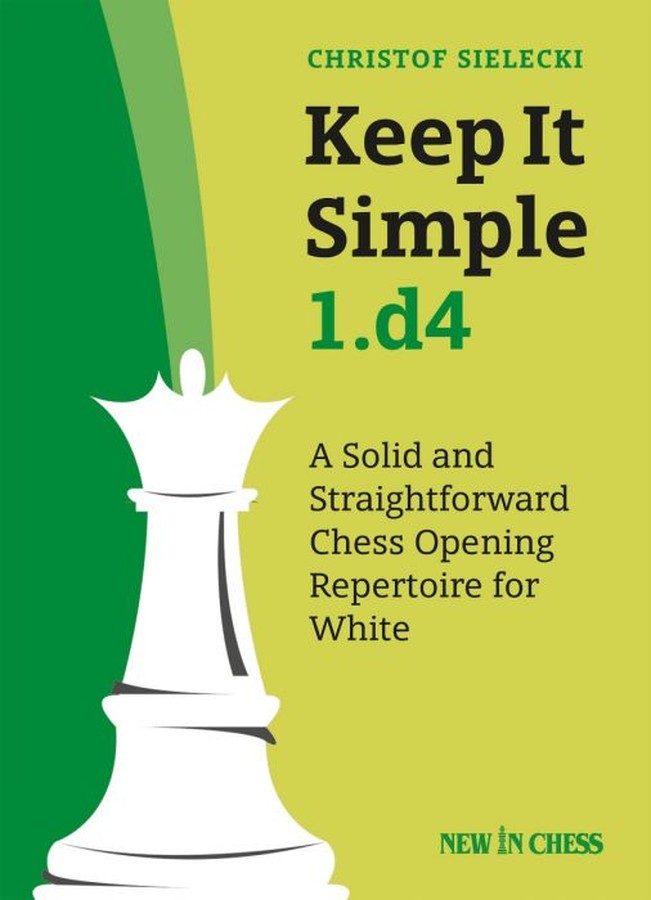| Nivå | B-D |
| Utgivelsesdato | November 2019 |
| Forfatter | |
| Pris | 370 NOK |
Keep it Simple 1. d4
A Solid and Straightforward Chess Opening Repertoire for WhiteEn solid stor repertoarbok for hvit med 1 d4 fulgt av 2 Sf3 og så hovedplanen å spille 3 c4, men det kan ikke folk vite.Trekkrekkefølgen unngår også noen åpninger som Budapestgambit og Benkögambit. "Denne boka kan vi dessverre ikke anbefale. Et slikt repertoar og særlig denne trekkrekkefølgen liker vi ikke å møte!" (ØB)
Er nok et utmerket åpningsbok for spillere med ratingnivå fra cirka 1200 og opp i mesterklassen.
Forlagets egen omtale
After the success of his award-winning book Keep it Simple 1.e4 International Master Christof Sielecki is back. His new repertoire based on 1.d4 has a similar profile: variations that are straightforward and easy to remember, and require little or no maintenance.
Sielecki has created a reliable set of opening lines for chess players of almost all levels. The major objective is to dominate Black from the opening, by simple means. You don’t need to sacrifice anything or memorize long tactical lines.
His main concept is for White to play 1.d4, 2.Nf3, 3.g3, 4.Bg2, 5.0-0 and in most cases 6.c4. Sielecki developed this repertoire while working with students who were looking for something that was easy to understand and easy to learn.
This new 1.d4 repertoire may be even easier to master than his 1.e4 recommendations, because it is such a coherent system. Sielecki always clearly explains the plans and counterplans and keeps you focussed on what the position requires. Ambitious players rated 1500 or higher will get great value out of studying this extremely accessible book.
Christof Sielecki is an International Master from Germany. He has been teaching and training chess for many years, and runs a popular YouTube channel called ChessExplained
Fra forfatterens innledning
A closer inspection, however, led to the concept for Keep it Simple: 1.d4. I noticed that many lines are complex for one reason: the early move c2-c4, which is usually played on move two. Black has many options based on the c4-pawn to steer the game into his territory, for example lines like the Queen’s Gambit Accepted or the Catalan with 1.d4 d5 2.c4 e6 3.♘f3 ♘f6 4.g3 dxc4. What if we just don’t play c2-c4 early on, but rather delay this move until we play it ‘on our terms’?
I wondered if it is possible to basically play the sequence of 1.d4, 2.♘f3, 3.g3, 4.♗g2, 5.0–0 and in most cases 6.c4, pretty much regardless of Black’s moves? I had seen some impressive games by Kramnik with this approach, and he knows what he is doing! If this could be the standard set-up, it would be much easier to handle the early move orders. In this case, you would only need to learn the exceptions, instead of completely different approaches to each and every defence Black may play. This idea fascinated me and I wondered what drawbacks this approach might have?My conclusion after a thorough analysis is: Black has some ideas to exploit our move order, but none of them put us in any danger. Black gets close to equality or equalizes with best play in some lines, but this should not discourage us too much. The important point to realize is: we are playing a slightly offbeat move order. Black might have seen some idea against 11Building a 1.d4 repertoireour move order, but he won’t be a specialist!
| Innbundet? | Nei |
| Type | Bok |
| Språk | Engelsk |
| Antall sider | 432 |

